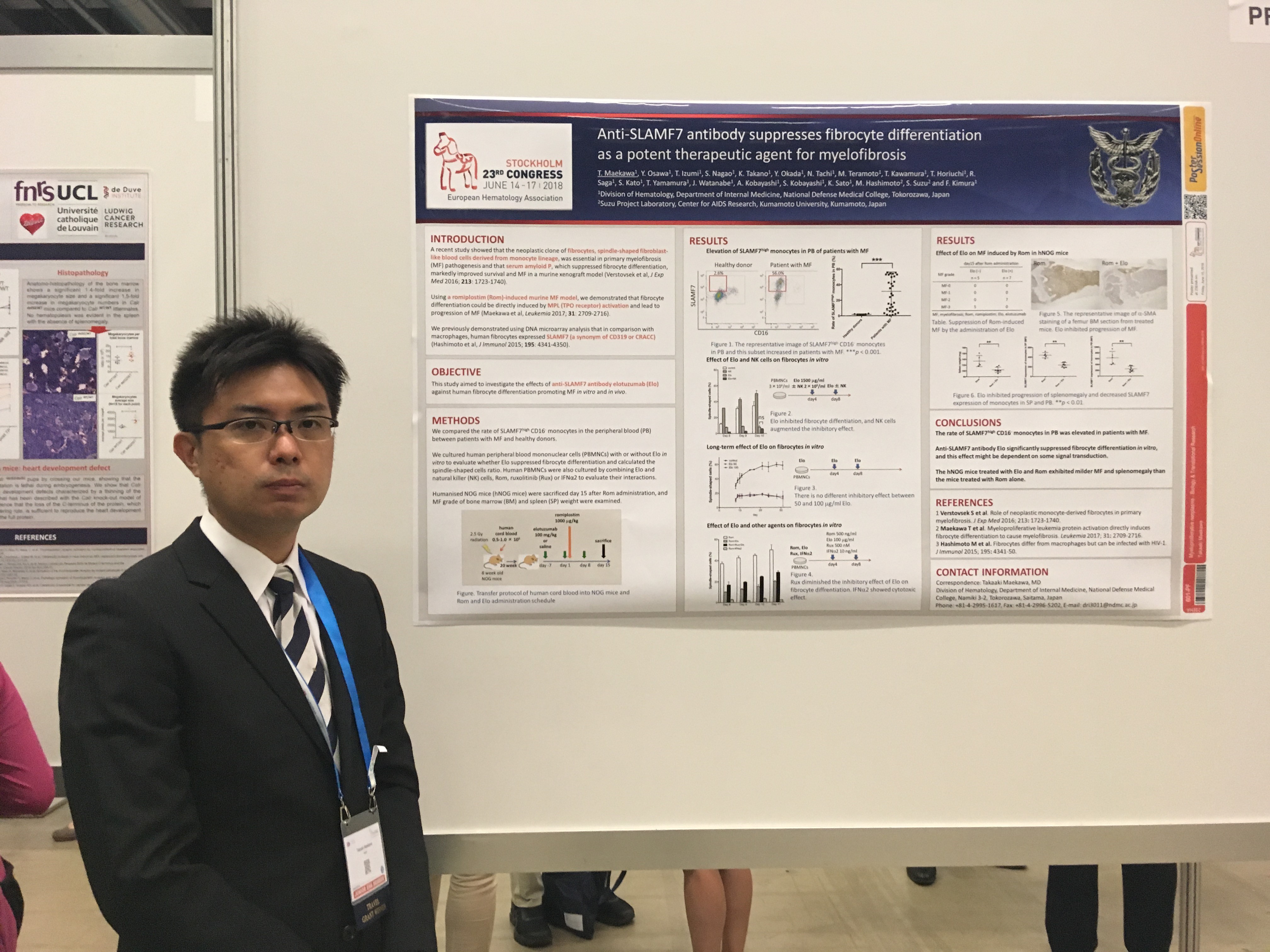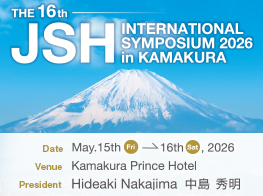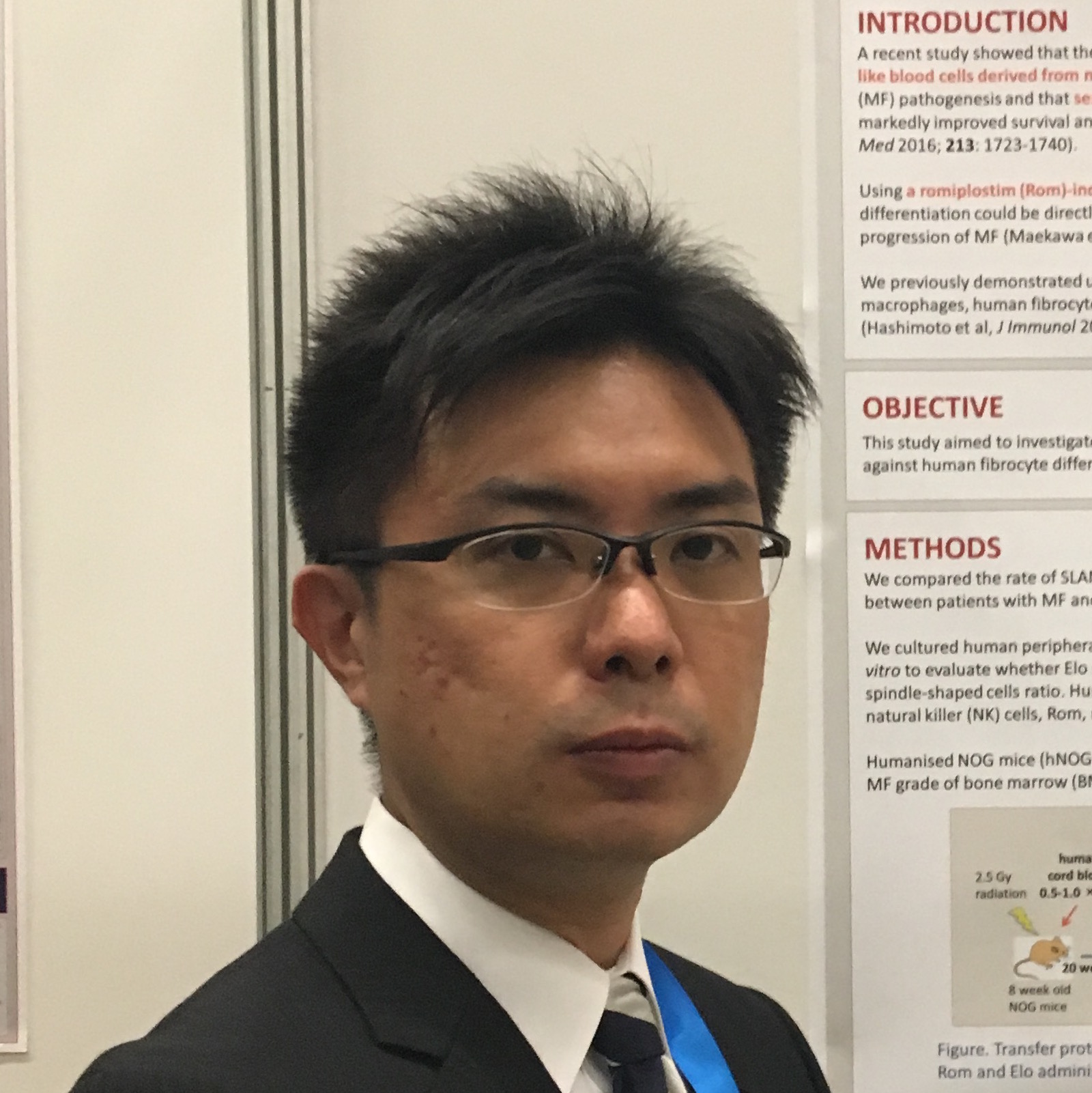名前:前川 隆彰【防衛医科大学校 内科学講座】
発表日時:2018年6月15日
発表形式:Poster
Title:
Anti-SLAMF7 antibody suppresses fibrocyte differentiation as a potent therapeutic agent for myelofibrosis
Authors:
Takaaki Maekawa1, Yukiko Osawa1, Takuya Izumi1, Shigeki Nagao1, Kosuke Takano1, Yosuke Okada1, Noriaki Tachi1, Masahiro Teramoto1, Toshikuni Kawamura1, Toshikatsu Horiuchi1, Reina Saga1, Shoichiro Kato1, Takeshi Yamamura1, Junichi Watanabe1, Ayako Kobayashi1, Shinichi Kobayashi1, Ken Sato1, Michihiro Hashimoto2, Shinya Suzu2, Fumihiko Kimura1
Affiliations:
1 Division of Hematology, Department of Internal Medicine, National Defense Medical College, Tokorozawa, Japan
2 Center for AIDS Research, Kumamoto University, Kumamoto, Japan
Abstract:
Background: Myelofibrosis (MF) occurrence can be attributed to various pathogenic mechanisms, such as elevated circulating cytokine levels, cellular interactions and genetic mutations. A recent study showed that the neoplastic clone of fibrocytes, spindle- shaped fibroblast-like blood cells derived from monocyte lineage, was essential in primary MF pathogenesis and that serum amyloid P (PRM-151), which suppressed fibrocyte differentiation, markedly improved survival and MF in a murine xenograft model. Using a romiplostim (Rom)-induced murine MF model, we demonstrated that fibrocyte differentiation could be directly induced by myeloproliferative leukaemia protein (MPL; TPO receptor) activation and lead to progression of MF. Fibrocytes are now one of the possible therapeutic targets for MF. We previously demonstrated using DNA microarray analysis that in comparison with macrophages, human fibrocytes expressed SLAMF7. Elotuzumab (Elo) is an anti-SLAMF7 antibody recently used for treating relapsed/refractory multiple myeloma, with encouraging results and promising safety. Here, we try to elucidate the efficacy of Elo as a therapeutic agent for MF.
Aims: This study aimed to investigate the effects of Elo against human fibrocyte differentiation promoting MF in vitro and in vivo.
Methods: We compared the SLAMF7 expression in monocytes of the peripheral blood between patients with MF and healthy donors. We cultured human peripheral blood mononuclear cells (PBMCs) with or without Elo in vitro to evaluate whether Elo suppressed fibrocyte differentiation and calculated the spindle-shaped cells ratio. Then, we cultured human PBMCs by combining Elo and natural killer (NK) cells, Rom, ruxolitinib or IFNα2 to evaluate their interactions. To evaluate the efficiency of Elo for a Rom- induced murine MF model, we transplanted human peripheral blood or cord blood stem cells into NOG mice with 2.5-Gy radiation, and administered 1 mg/kg Rom once a week after 8-12 weeks of transplantation. Humanised NOG mice were sacrificed 1 to 2 weeks after Rom administration, and MF grade of bone marrow and spleen weight were examined.
Results: In comparison to healthy donors, the SLAMF7 expression in monocytes of the peripheral blood was significantly increased in patients with MF. While Elo independently inhibited fibrocyte differentiation from human PBMCs, NK cells augmented the inhibitory effect. Fifty and 100 μg/ml of Elo showed comparable inhibitory effect for fibrocyte differentiation in vitro. Elo represented the inhibitory effect even after Rom administration, and addition of ruxolitinib diminished the inhibitory effect of Elo on fibrocyte differentiation. IFNα2 demonstrated the severe cytotoxic effect. In humanised NOG mice, Elo administration suppressed MF development. Amelioration of splenomegaly and anaemia was also observed in mice treated with Elo and Rom than Rom alone.
Conclusions: The SLAMF7 expression was elevated in monocytes of patients with MF. Anti-SLAMF7 antibody Elo administration significantly suppressed fibrocyte differentiation in vitro, and ameliorated MF in vivo. Elo could be a potential therapeutic agent for MF, and this effect of Elo may be partly dependent on the JAK-STAT pathway.
EHA2018参加レポート
私はこの度スウェーデンのストックホルムで開催された23rd Congress of EHAに参加させて頂きました。6月のストックホルムは非常に気候が良く日も長く,美しい街並みと共に夜には旬のホワイトアスパラやアイリッシュクラブ,そして伝統のミートボールなどの料理も堪能させて頂きました。
私は大学院に入る1年前,2013年から2014年の間,熊本のエイズ学研究センターで研修させて頂き,基礎研究の基本を学ばせて頂きました。その際に,研究室長の鈴伸也教授が研究されていた,fibrocyteという細胞に興味を持ちました。Fibrocyteとは単球系から分化するfibroblast様の形態と機能を持つ血球系の細胞で,当時から肺線維症などの線維化疾患における病因の一つとして注目されていました。私の現在の研究は,このfibrocyteが骨髄線維症の病因に関与しているかどうか調べてみたい,ということから始まりました。
研究を始めてから約2年間,思うような研究成果を上げられず,研究テーマを変えようと考えたことも幾度もありました。そのような中で,romiplostim投与による骨髄線維症モデルマウスの作成,SV40Tマウスを用いたマウスfibrocyte細胞株の作成など小さな成功を積み重ねて少しずつ研究を前に進めていきました。研究の大きな転機としては,クロドロン酸リポソームによる単球/マクロファージ系の除去が骨髄線維症モデルマウスの脾腫および骨髄線維化を著明に改善したこと,また,MD Andersonの研究グループが原発性骨髄線維症患者において腫瘍化したfibrocyteが骨髄線維化の発症に寄与していることを証明したことが挙げられます。これらの成果によって,fibrocyteが骨髄線維症の発症に関与していることに確信を持つことができました。
前述のMD Andersonの研究グループはまた同時に,serum amyroid Pというfibrocyteの分化を抑制する薬剤が骨髄線維症モデルマウスの症状を軽減し,生存を延長することを示しました。現在我々もfibrocyteを標的とした治療法について研究を進めており,fibrocyteに高発現しているSLAMF7に注目しています。今回のEHAでは,抗SLAMF7抗体であるelotuzumabのin vitroでのfibrocyteの分化抑制作用,および骨髄線維症モデルマウスに対するin vivoでの有効性について発表させて頂きました。ポスター発表に際しては各国の研究者と活発な討議を行うことができ,今後の研究に向けて非常に有意義なアイデアを得ることができました。
学会最終日の午後にはノーベル賞受賞者に対する記念晩餐会が開催されるストックホルム市庁舎を訪れ,会場の荘厳な雰囲気に感銘を受けました。ノーベル氏の"If I come up with 300 ideas in a year, and only one of them is useful, I am content."の言葉にもある通り,研究はうまくいかないことばかりですが,だからこそ常に新しいアイデアを考え続けることと,小さな成功を足掛かりに少しずつ成果を積み上げていくことが何より大切と考えております。今後も細々と,しかし途絶えることなく研究を続けていき,いつの日か患者さんの治療に役立つ日がくればこの上ない幸いです。
最後に,このような機会を与えて頂きました日本血液学会事務局および国際委員会の諸先生方に心より感謝申し上げます。また,日頃より御指導いただいております防衛医科大学校血液内科 木村文彦教授,当科医局員の皆様,並びに本研究に関わって頂いた全ての皆様にこの場を借りまして厚く御礼申し上げます。そして,常日頃から研究生活を支えてくれている家族への感謝をここに記し,私の23rd Congress of EHA参加報告とさせて頂きます。





